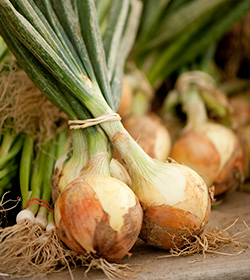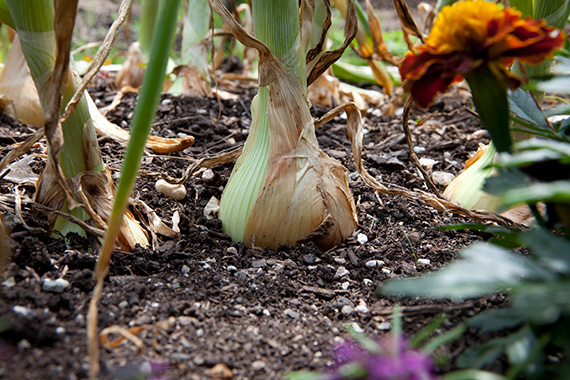Mighty Onions: Part II
Posted in Gardening Tips on April 8 2014, by Sonia Uyterhoeven
Sonia Uyterhoeven is the NYBG’s Gardener for Public Education.
 Last week we discussed different onion varieties and explored several ways to prevent the tears from flowing once these spicy bulbs go under the knife. This week, we’re switching gears to discuss planting techniques and focus on successfully growing our onions this season.
Last week we discussed different onion varieties and explored several ways to prevent the tears from flowing once these spicy bulbs go under the knife. This week, we’re switching gears to discuss planting techniques and focus on successfully growing our onions this season.
This is the time of year that I start heading down to the farmer’s market in search of onion transplants, which are generally sold in a small, 2-inch pot—all crammed in together. They need to be thinned as well as planted. Once I get into the garden, I take the mass out of the pot and drop it to the ground, letting the root ball shatter and the minuscule transplants separate from each other. With a trowel held like a dagger in one hand and the transplants in the other, I stab the ground and place them 1 – 2 inches deep and an inch apart. In less than a month you will be pulling them up and tossing them into your salad.
If you are growing long-season onions, your spacing should be more generous for transplants: 1 – 2 inches deep and 2 – 6 inches apart, depending on the size of the variety’s mature bulb. You can always plant them closer if you plan to thin them out and use the immature bulbs as bunching onions.
Aside from transplants—and I find many interesting varieties available at farmer’s markets these days—seed sowing is a more labor-intensive but perhaps more gratifying approach. For quick crops such as bunching onions (scallions) or Cipollini onions that take 60 days to mature, you can sow the seeds directly into the garden in mid-April once the soil starts to dry and is workable for planting.
You can also sow your onion seeds indoors 8 – 10 weeks before the last frost date. They will then be ready for outdoor planting around 2 – 4 weeks before the last frost. If the transplants get too droopy, cut them back to 3 inches. Indoor sowing or buying transplants is advisable for long-season varieties that need time to mature.
Another way to plant your onions is from sets. A set is a tiny, dormant bulb. These can be planted 1/2 – 1 inch deep, but make sure your sets are no more than 3/4-inch in diameter, otherwise they have a propensity to bolt.
Once you’re up and growing, there are a few things to remember about onions. To start, they like full sun and good drainage. They have a shallow root system, so they don’t like to dry out—nor are they fond of weeds. Onions will love the cooler temperatures in the spring and require warmer temperatures when they start to bulb up.
Supplement your soil with manure or compost before you plant and you should not have to fertilize your onions for the rest of the season. But if you are fertilizing, make sure you don’t use a heavy nitrogen fertilizer that promotes foliage, and cease all fertilizing once the bulb starts to form. Be sure to add mulch around your onions to keep the weeds away, but as they mature, don’t bury the emerging bulbs—they need to be exposed.
Stop watering your onions once the tops start to turn yellow and fall over. Bend the tops over with a rake to accelerate the process. Loosen the soil around the bulbs to encourage drying. Once the tops are brown, gently dig your onions up—being careful not to bruise them—and let them dry on top of the soil for a few days. Once the outer layer is dry, place the onions in a root cellar or a cool, dry place for several weeks. Depending on the variety of onion that you have grown, and the care you have given, the stored onions will last for between 4 months and a year. Short-day onions that are known for their sweetness aren’t so good with storage, and will last between 4 – 6 weeks.
Once the gardening is done with, it’s time to hit the kitchen. When using scallions, bunching onions, or spring onions (all the same thing), wash them, cut them into smaller pieces that store easily, and keep them in an airtight container in the refrigerator. If you don’t protect them, the air in the refrigerator dries them out, but if well sealed they should stay fresh for over two weeks.
And one final plug for onions: the tops are high in Vitamin A; the bulbs help the body absorb Vitamin C and support your immune system; and onions help reduce inflammation to heal infections. The juice of an onion can even relieve the pain from a bee sting. Bad breath has never been so good!

